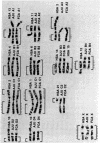Abstract
The recent derivation of a biochemical map of 33 loci of the domestic cat (Felis catus) revealed a striking conservation of chromosomal linkage associations between the cat and humans. A comparison of homologous (by linkage criteria) chromosomes by using conventionally extended and high-resolution G-banding of human and feline chromosomes is presented. Four criteria for establishing probable cytogenetic homologies of chromosomal regions were invoked: (i) map placement of homologous genes to the same chromosomes; (ii) cytological correlation of G-banding pattern; (iii) placement of homologous genes, by regional gene mapping, in the region of cytological homology; and (iv) a requirement that the putative region of homology be ancestral and evolutionarily conserved within their respective orders. Five subchromosomal regions (homologous to human chromosome 1p, 2p, 2q, 12, and X) were found to be conserved and homologous by all the stated criteria. The conserved regions constitute nearly 20% by length of the human chromosomal genome. The implications of conservation of chromosome homologies between mammalian orders whose last common ancestor became extinct more than 60 million years ago is discussed.
Full text
PDF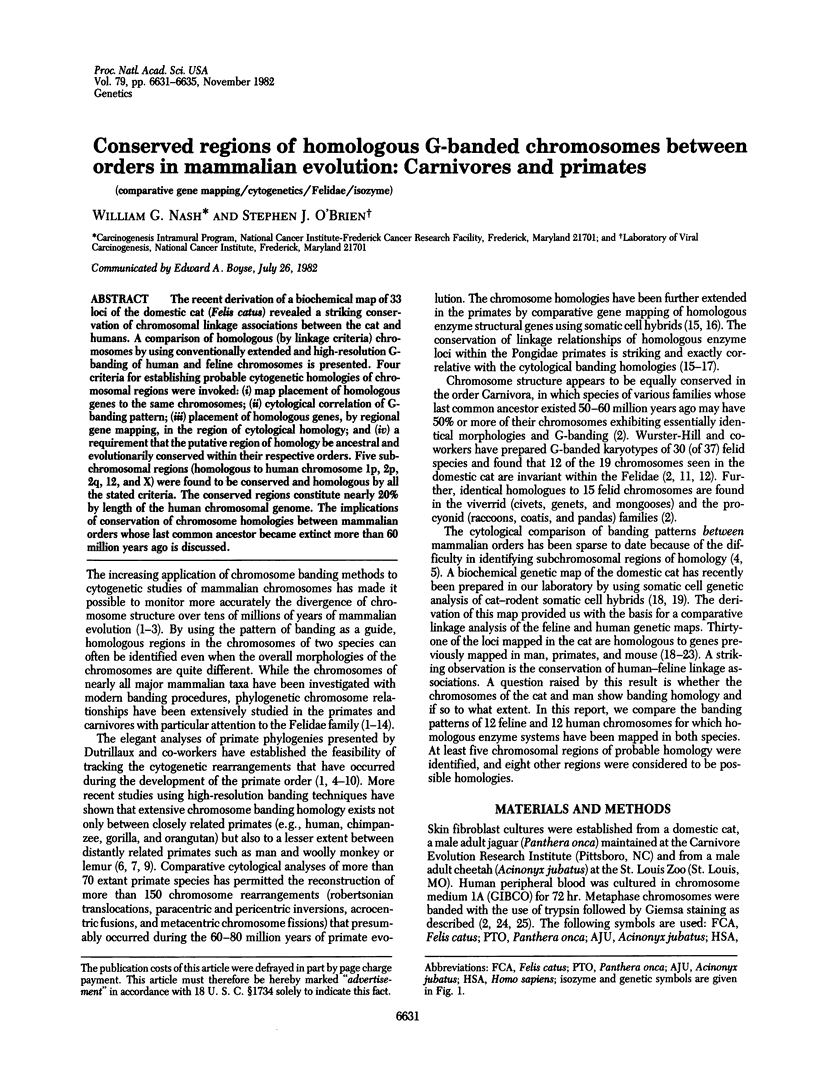
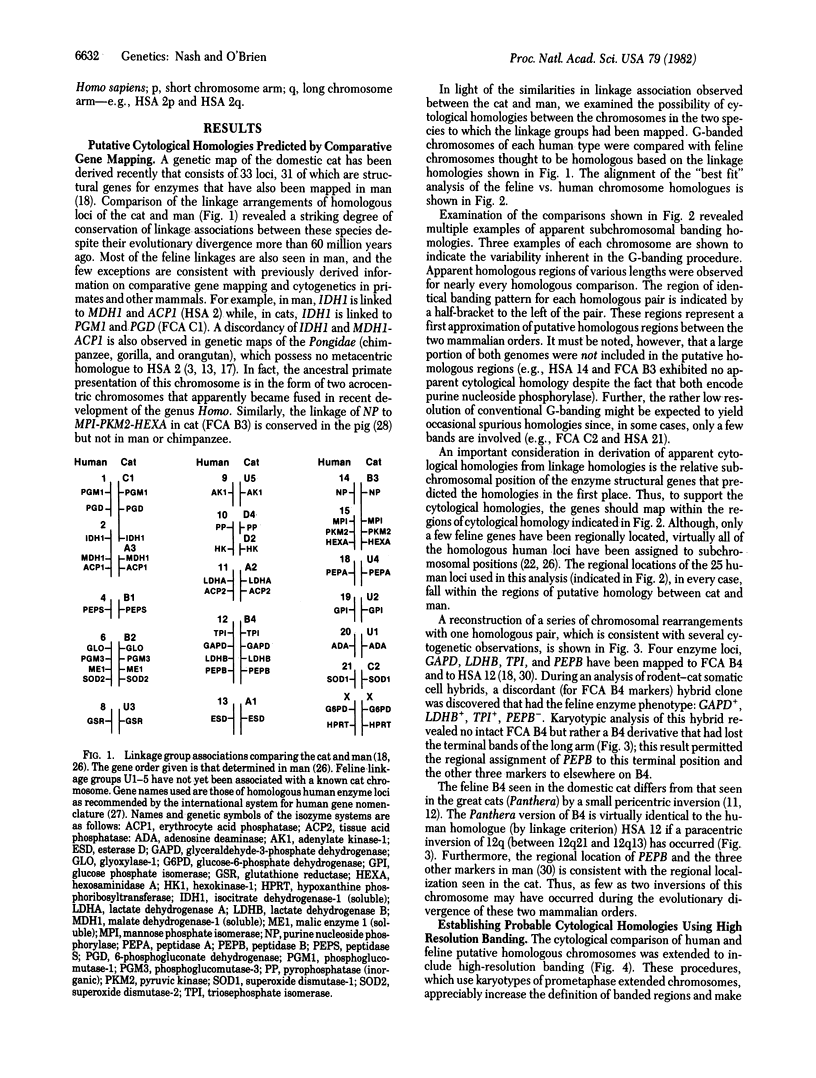
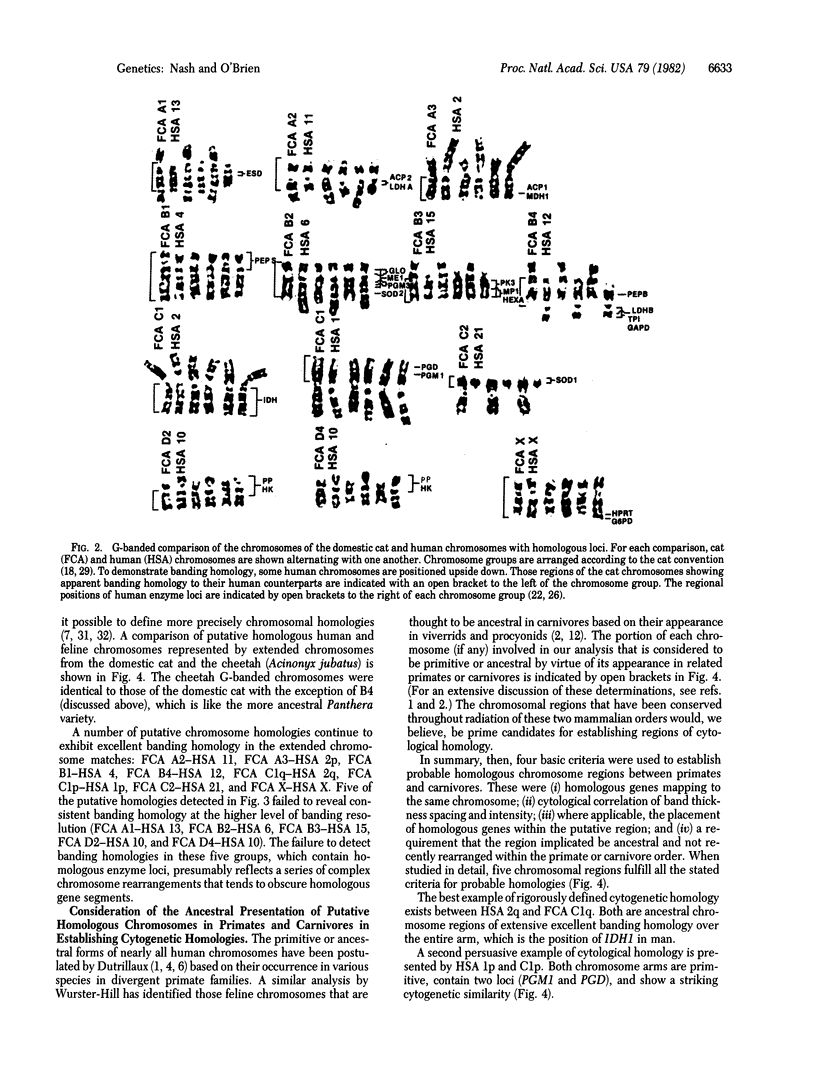
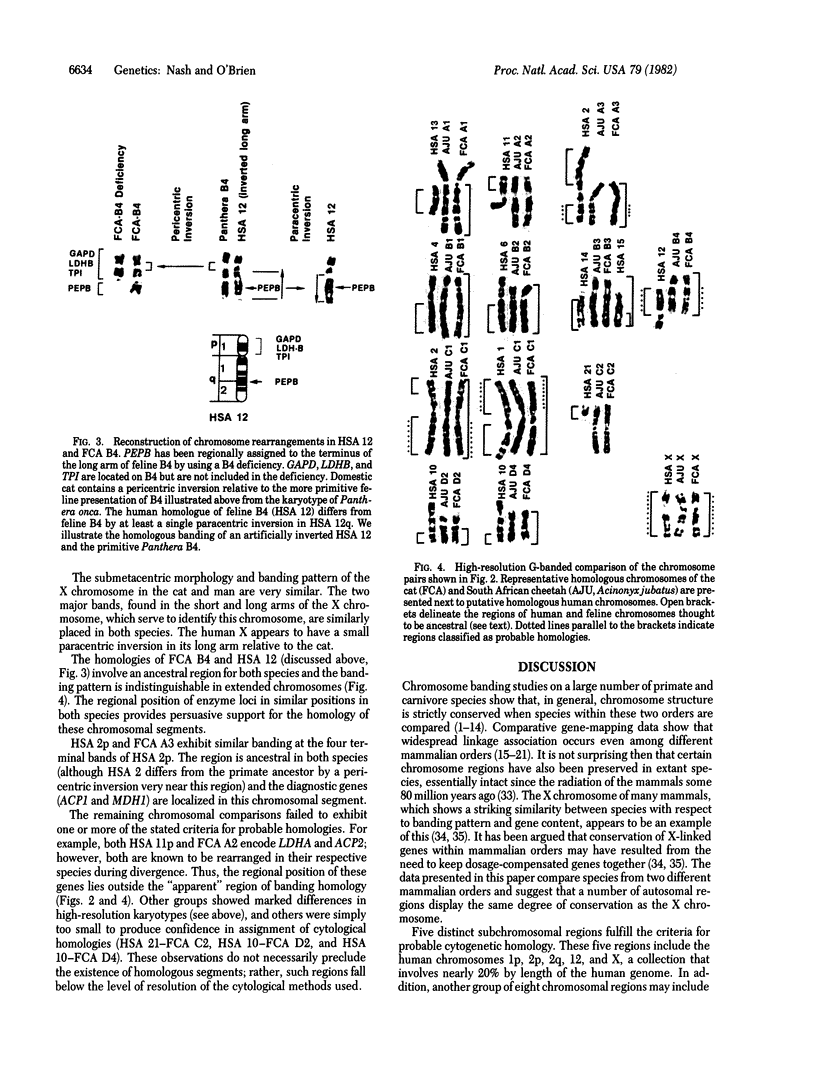
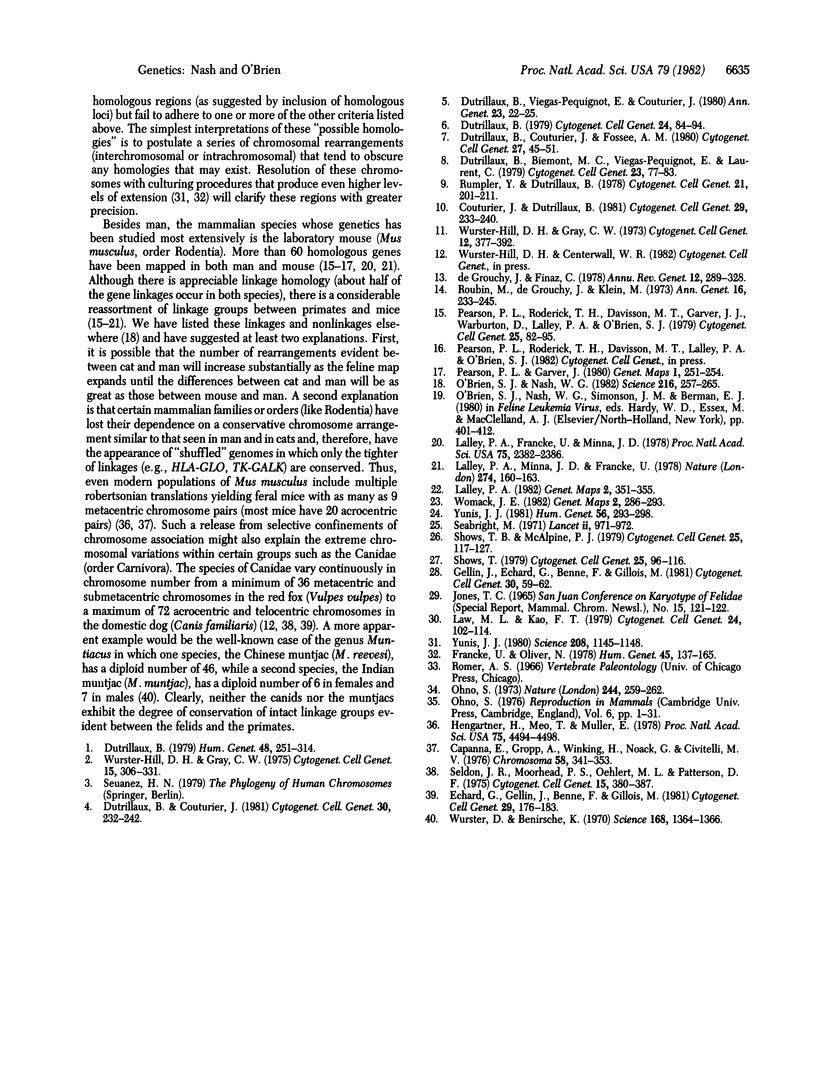
Images in this article
Selected References
These references are in PubMed. This may not be the complete list of references from this article.
- Capanna E., Gropp A., Winking H., Noack G., Civitelli M. V. Robertsonian metacentrics in the mouse. Chromosoma. 1976 Nov 29;58(4):341–353. doi: 10.1007/BF00292842. [DOI] [PubMed] [Google Scholar]
- Couturier J., Dutrillaux B. Conservation of replication chronology of homologous chromosome bands between four species of the genus Cebus and man. Cytogenet Cell Genet. 1981;29(4):233–240. doi: 10.1159/000131574. [DOI] [PubMed] [Google Scholar]
- Dutrillaux B., Biemont M. C., Viegas-Pequignot E., Laurent C. Comparison of the karyotypes of four Cercopithecoidae: Papio papio, P. anubis, Macaca mulatta, and M. fascicularis. Cytogenet Cell Genet. 1979;23(1-2):77–83. doi: 10.1159/000131305. [DOI] [PubMed] [Google Scholar]
- Dutrillaux B. Chromosomal evolution in primates: tentative phylogeny from Microcebus murinus (Prosimian) to man. Hum Genet. 1979 May 10;48(3):251–314. doi: 10.1007/BF00272830. [DOI] [PubMed] [Google Scholar]
- Dutrillaux B., Couturier J., Fosse A. M. The use of high resolution banding in comparative cytogenetics: comparison between man and Lagothrix lagotricha (Cebidae). Cytogenet Cell Genet. 1980;27(1):45–51. doi: 10.1159/000131463. [DOI] [PubMed] [Google Scholar]
- Dutrillaux B., Couturier J. The ancestral karyotype of platyrrhine monkeys. Cytogenet Cell Genet. 1981;30(4):232–242. doi: 10.1159/000131614. [DOI] [PubMed] [Google Scholar]
- Dutrillaux B. Very large analogy of chromosome banding between Cebus capucinus (Platyrrhini) and man. Cytogenet Cell Genet. 1979;24(2):84–94. doi: 10.1159/000131361. [DOI] [PubMed] [Google Scholar]
- Dutrillaux B., Viegas-Pequignot E., Couturier J. Très grande analogie de marquage chromosomique entre le lapin (Oryctolagus cuniculus) et les primates, dont l'homme. Ann Genet. 1980;23(1):22–25. [PubMed] [Google Scholar]
- Echard G., Gellin J., Benne F., Gillois M. The gene map of the rabbit (Oryctolagus cuniculus L.) I. Synteny between the rabbit gene loci coding for HPRT, PGK, G6PD, and GLA: their localization on the X chromosome. Cytogenet Cell Genet. 1981;29(3):176–183. doi: 10.1159/000131566. [DOI] [PubMed] [Google Scholar]
- Francke U., Oliver N. Quantitative analysis of high-resolution trypsin-giemsa bands on human prometaphase chromosomes. Hum Genet. 1978 Dec 18;45(2):137–165. doi: 10.1007/BF00286957. [DOI] [PubMed] [Google Scholar]
- Gellin J., Echard G., Benne F., Gillois M. Pig gene mapping: PKM2-MPI-NP synteny. Cytogenet Cell Genet. 1981;30(1):59–62. doi: 10.1159/000131590. [DOI] [PubMed] [Google Scholar]
- Hengartner H., Meo T., Müller E. Assignment of genes for immunoglobulin kappa and heavy chains to chromosomes 6 and 12 in mouse. Proc Natl Acad Sci U S A. 1978 Sep;75(9):4494–4498. doi: 10.1073/pnas.75.9.4494. [DOI] [PMC free article] [PubMed] [Google Scholar]
- Lalley P. A., Francke U., Minna J. D. Homologous genes for enolase, phosphogluconate dehydrogenase, phosphoglucomutase, and adenylate kinase are syntenic on mouse chromosome 4 and human chromosome 1p. Proc Natl Acad Sci U S A. 1978 May;75(5):2382–2386. doi: 10.1073/pnas.75.5.2382. [DOI] [PMC free article] [PubMed] [Google Scholar]
- Lalley P. A., Minna J. D., Francke U. Conservation of autosomal gene synteny groups in mouse and man. Nature. 1978 Jul 13;274(5667):160–163. doi: 10.1038/274160a0. [DOI] [PubMed] [Google Scholar]
- Law M. L., Kao F. T. Regional assignment of human genes TPI1, GAPDH, LDHB, SHMT, and PEPB on chromosome 12. Cytogenet Cell Genet. 1979;24(2):102–114. doi: 10.1159/000131363. [DOI] [PubMed] [Google Scholar]
- O'Brien S. J., Nash W. G. Genetic mapping in mammals: chromosome map of domestic cat. Science. 1982 Apr 16;216(4543):257–265. doi: 10.1126/science.7063884. [DOI] [PubMed] [Google Scholar]
- Ono S. Ancient linkage groups and frozen accidents. Nature. 1973 Aug 3;244(5414):259–262. doi: 10.1038/244259a0. [DOI] [PubMed] [Google Scholar]
- Pearson P. L., Roderick T. H., Davisson M. T., Garver J. J., Warburton D., Lalley P. A., O'Brien S. J. Report of the committee on comparative mapping. Cytogenet Cell Genet. 1979;25(1-4):82–95. doi: 10.1159/000131403. [DOI] [PubMed] [Google Scholar]
- Roubin M., de Grouchy J., Klein M. Les félidés: évolution chromosomique. Ann Genet. 1973 Dec;16(4):233–245. [PubMed] [Google Scholar]
- Rumpler Y., Dutrillaux B. Chromosomal evolution in Malagasy lemurs. III. Chromosome banding studies in the genus Hapalemur and the species Lemur catta. Cytogenet Cell Genet. 1978;21(4):201–211. doi: 10.1159/000130897. [DOI] [PubMed] [Google Scholar]
- Seabright M. A rapid banding technique for human chromosomes. Lancet. 1971 Oct 30;2(7731):971–972. doi: 10.1016/s0140-6736(71)90287-x. [DOI] [PubMed] [Google Scholar]
- Selden J. R., Moorhead P. S., Oehlert M. L., Patterson D. F. The Giemsa banding pattern of the canine karyotype. Cytogenet Cell Genet. 1975;15(6):380–387. doi: 10.1159/000130537. [DOI] [PubMed] [Google Scholar]
- Shows T. B., Alper C. A., Bootsma D., Dorf M., Douglas T., Huisman T., Kit S., Klinger H. P., Kozak C., Lalley P. A. International system for human gene nomenclature (1979) ISGN (1979). Cytogenet Cell Genet. 1979;25(1-4):96–116. doi: 10.1159/000131404. [DOI] [PubMed] [Google Scholar]
- Shows T. B., McAlpine P. J. The 1979 catalog of human genes and chromosome assignments. Cytogenet Cell Genet. 1979;25(1-4):117–127. doi: 10.1159/000131405. [DOI] [PubMed] [Google Scholar]
- Wurster-Hill D. H., Gray C. W. The interrelationships of chromosome banding patterns in procyonids, viverrids, and felids. Cytogenet Cell Genet. 1975;15(5):306–331. doi: 10.1159/000130528. [DOI] [PubMed] [Google Scholar]
- Wurster D. H., Benirschke K. Indian muntjac, Muntiacus muntjak: a deer with a low diploid chromosome number. Science. 1970 Jun 12;168(3937):1364–1366. doi: 10.1126/science.168.3937.1364. [DOI] [PubMed] [Google Scholar]
- Yunis J. J. Mid-prophase human chromosomes. The attainment of 2000 bands. Hum Genet. 1981;56(3):293–298. doi: 10.1007/BF00274682. [DOI] [PubMed] [Google Scholar]
- Yunis J. J., Sawyer J. R., Dunham K. The striking resemblance of high-resolution G-banded chromosomes of man and chimpanzee. Science. 1980 Jun 6;208(4448):1145–1148. doi: 10.1126/science.7375922. [DOI] [PubMed] [Google Scholar]
- de Grouchy J., Turleau C., Finaz C. Chromosomal phylogeny of the primates. Annu Rev Genet. 1978;12:289–328. doi: 10.1146/annurev.ge.12.120178.001445. [DOI] [PubMed] [Google Scholar]




